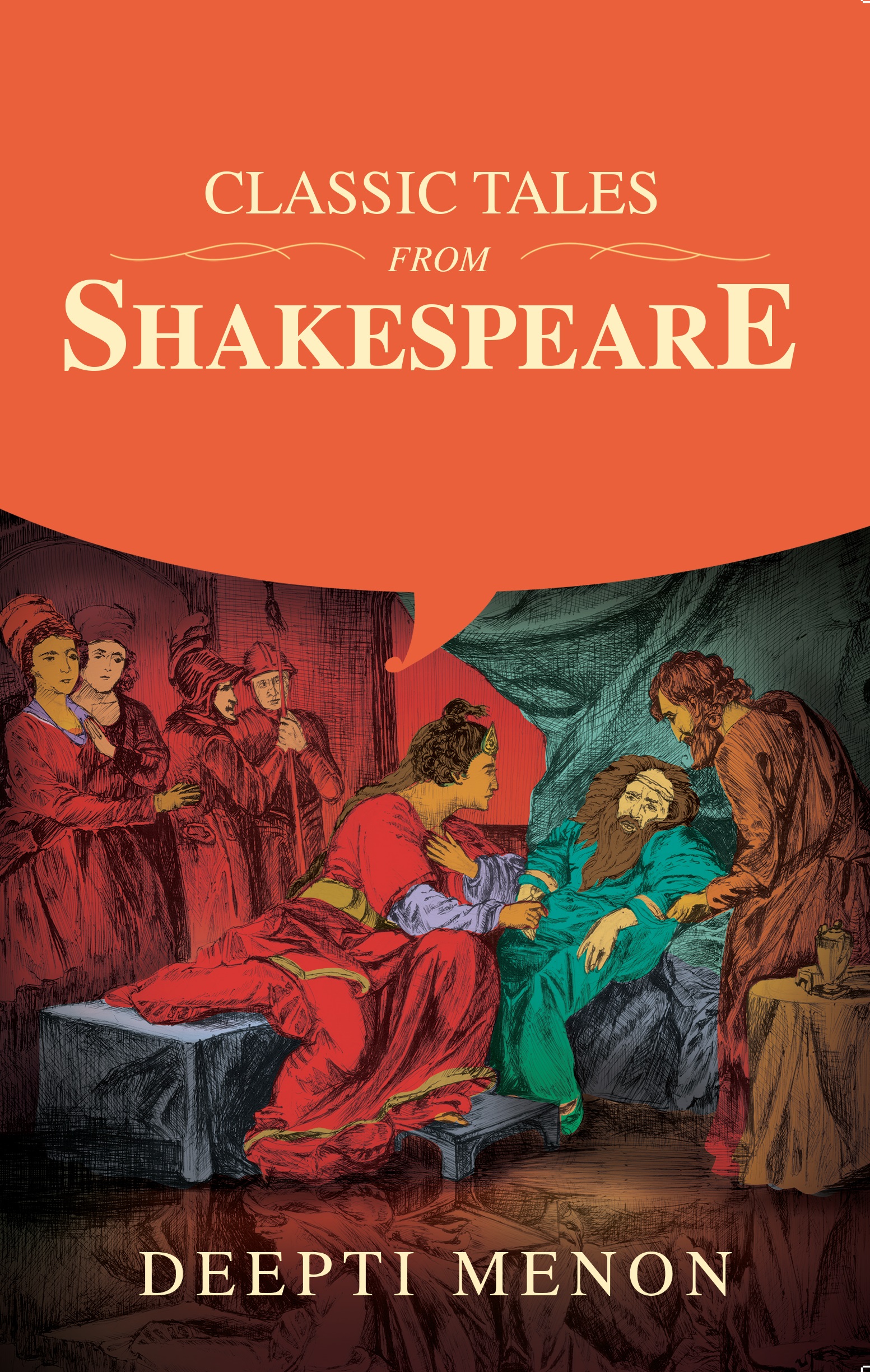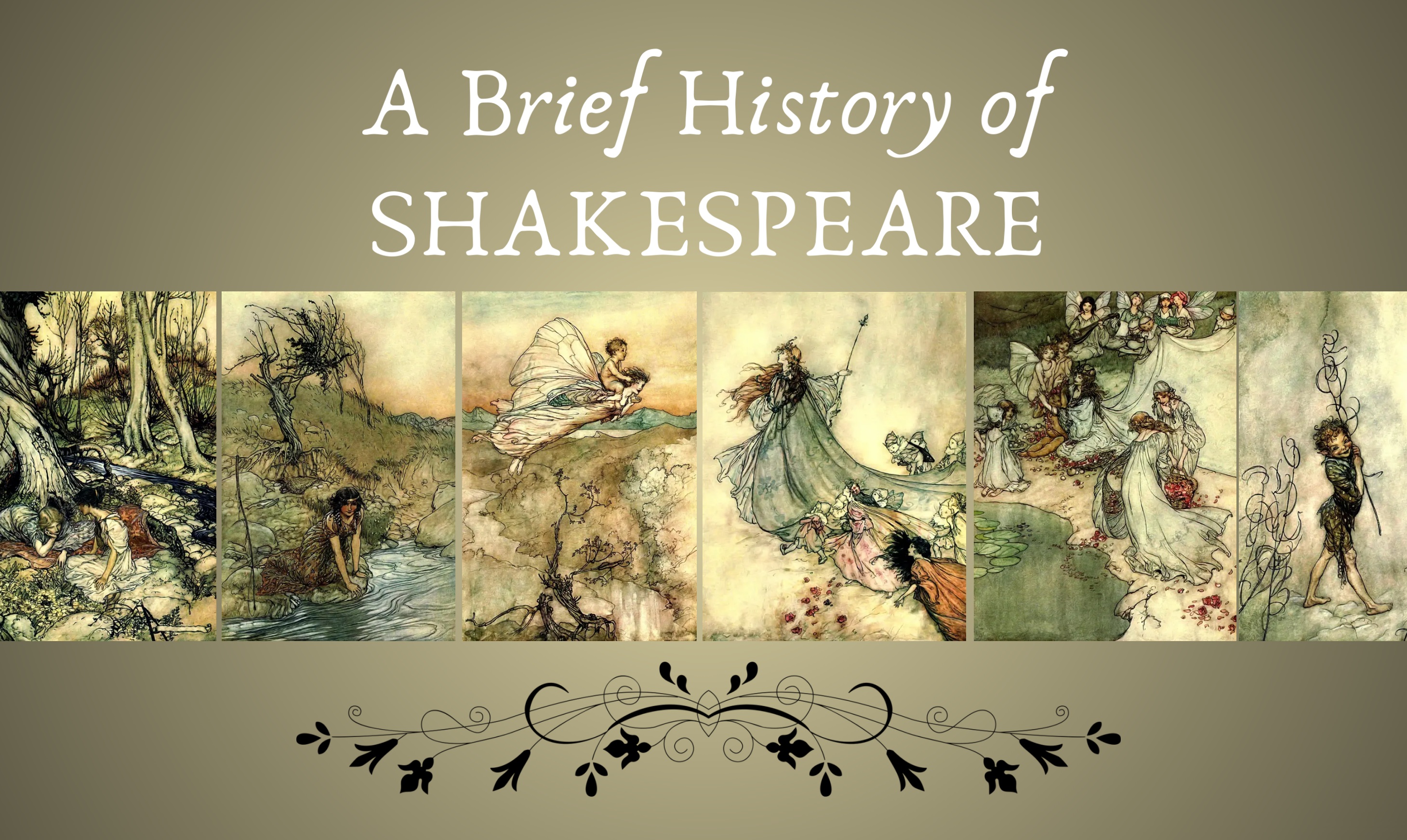Is there anyone in the world of literature who has not heard of the Bard of Avon, William Shakespeare, the most celebrated writer and playwright of all times? His plays have been translated into over 50 languages and performed in the Globe Theatre (and across the globe!) for many centuries.
The Beginning: William was born to John and Mary Shakespeare (nee Arden) on the 23rd of April 1564 at Stratford-upon-Avon, Warwickshire, England. One of eight children, he was educated at the King’s New School where he studied grammar and the Latin text, but as he was from common stock, he finished school at the grammar school level. No fancy degrees for him, and no record of his attending college, which was an upper-class thing to do. During those days, he did dabble at acting.
The Wedding: When Shakespeare was eighteen, he met the 26-year-old Anne Hathaway. As is drolly put, Anne ‘hath her way’ and the two were soon wed in 1582. Six months later, their daughter, Susanna was born. They went on to have a pair of twins in 1585 – Hamnet who died early at the age of 11 and Judith. Susanna’s daughter, Elizabeth, his only grandchild, died childless, and sadly, the family line of the illustrious William Shakespeare ended there.
The Lost Years: From 1585 onwards, Shakespeare disappeared from the public eye, ensconced somewhere in London, re-emerging in 1592 with his two long poems – Venus and Adonis (1593) and The Rape of Lucrece (1594). While Shakespeare is acclaimed as a master dramatist, he wrote myriad notable poems as well, which he continued to do even as he fell in and out of love. His Love Sonnets are proof of his smitten heart.
Master Playwright: What would you call a genius who produced an average of two plays a year for almost twenty years? Prolific would be too tame a word, I suspect. William had already shown signs of being an actor, and in his early years as a dramatist, he founded an acting company called the Lord Chamberlain’s Men. In 1599, he had disproved his own quote that “All that glisters is not gold” when he created his own theatre on the banks of the Thames and dubbed it The Globe Theatre. By this time, he had accrued properties and wealth and considered himself a reasonably well-to-do personage.
It was around then that his name began being published on the title page of his plays, as his mere name ensured that his audiences filled the theatres. It is rumoured that he performed a few roles himself, notably the ghost in Hamlet and Adam in As You Like It.
Queen Elizabeth I witnessed several of Shakespeare’s plays. Later, he also had a royal admirer in King James and under his patronage, he changed the name of his company to The King’s Men.
William now had properties in Stratford where he lived the life of a successful businessman and London where he was seen as a renowned playwright.
The Plays: It is believed that the Bard wrote at least 38 plays between 1590 and 1612. The range of his themes was all-encompassing, and his plays can be divided into comedies, histories, tragedies, and tragicomedies, though some plays walked a tightrope between these categories.
His Historical Plays: 1589-1593: Shakespeare’s first three plays were Henry VI (parts1,2 &3), while the fourth one was Richard III, all based on the tumult and the action of English politics. Thereafter, he shifted his energies to the other two categories, returning to historical plays later, such as Henry IV, Henry V, King John, and Henry VIII. In these, he offered a commentary on the socio-political scene of the times, in the backdrop of the Hundred Years War with France.
However, his most loved historical plays have always been Julius Caesar and Antony and Cleopatra.
His Comedies: 1592 -1600: Shakespeare revealed a different side of himself as he penned comedies like The Comedy of Errors, The Taming of the Shrew, The Two Gentlemen of Verona, Love’s Labour Lost, A Midsummer Night’s Dream, As You Like It and Twelfth Night.
The comedies were in high demand as the audiences enjoyed the rapier-sharp dialogues, the cutting irony, and the dazzling wordplay that Shakespeare is so well known for. They were eye-catching spectacles brimming over with convoluted plots, disguises, and mistaken identities, often leading to a hilarious unmasking.
Themes like love, friendship, envy, light, poignancy, and darkness were repeated, and the public lapped them all up, enjoying the contrast these plays offered to their own mundane lives.
A Midsummer Night’s Dream, for example, was like an idyllic vision with fairies, spirits, and ethereal creatures. At the end, Puck comes forth and proclaims, “All is mended, that you have but slumbered here while these visions did appear.” The audience, indeed, awakes from a reverie.
His Tragedies: 1603 – 1606: Shakespeare’s tragedies were proof that the playwright had moved beyond the hurly-burly of normal life to the epic emotional whirlpools that the audiences were caught in as they watched larger-than-life heroes yield to hubris or fatal flaws, only to end their lives sunk in the depths of despair. Be it Macbeth and his vaulting ambition, Othello and his green-eyed monster of envy, Hamlet and his “to be or not to be” vacillation or King Lear and his possessiveness of his daughters leading to insanity, these heroes “strutted and fretted their way across the stage, full of sound and fury.”
His Tragicomedies: As I have mentioned earlier, some of Shakespeare’s plays veered between tragedy and comedy, and these fell into the rare category we know as tragicomedy. The Winter’s Tale, Cymbeline, Much Ado About Nothing, The Merchant of Venice, and The Tempest were sweeping tales that went the whole gamut with complex plots and soaring emotions. By those standards, Romeo and Juliet which began as a romance ended as a double tragedy.
His Late Romances: 1609 – 1623: Pericles, The Winter’s Tale, and The Tempest are often classified as the Bard’s late romances, plays that showed a maturity that tempered the imagination of the playwright, portraying themes of serenity, godliness, and forgiveness.
The Sonnets of Shakespeare: When one reads the sonnets of the Bard, they come across as intensely personal, often romantic, and sometimes even erotic. Were they pages from a deeply private diary which were never meant to see the light of day? They revealed the troubled mind of the poet-dramatist and the dilemmas that he went through during his turbulent love life.
There are over 150 sonnets written during his lifetime and published much later in his life. What is intriguing is that the sonnets were written to two distinctly different people. One entire set dwells on the Bard’s desire for a Dark Lady who was obviously married. The other set is addressed to a Fair Youth, a love that created a conflict in the mind of the writer, leading to speculations on Shakespeare’s romantic preferences, as well as his views on matrimony, religion, life, and love.
His Language: In Elizabethan times, England was divided into different social groups, the broadest being the aristocracy and the commoners. Shakespeare’s plays were a curious blend of prose and verse, which denoted their social standing. The common characters spoke in prose, and the cruder they were, the lower their background. The noble characters resorted to the incredibly popular iambic pentametre, ten syllables in each line alternating between stressed and unstressed rhythms.
His language was picturesque, almost exaggerated at times. Some of the most colourful sayings in the English language come from his plays. It is believed that he introduced almost 1700 original words to the English language, and dictionary.

Image Source: earthlymission.com
His Works: Could you imagine a world devoid of the incredible works of Shakespeare? Something akin to the musical romantic movie by Danny Boyle ‘Yesterday’ which imagined a world where the iconic Beatles never existed?
In the case of the Bard, the world would never have realised the loss, but it would have been a colossal loss, indeed. The original manuscripts are non-existent. We owe an immense sense of gratitude to a group of actors belonging to Shakespeare’s company who collected and preserved several of his plays after the great playwright passed away. They created the First Folio in which nestled 36 plays and none of his poetry.
His Adaptations: There have been some stunning adaptations of Shakespeare’s plays over the decades, starting from Akira Kurosawa’s samurai Macbeth (Throne of Blood) in 1957 and Hamlet in 1960 (The Bad Sleep Well) to a Russian Hamlet in 1964, Peter Brooks’ King Lear in 1962 to a Russian King Lear in 1971, Baz Luhrmann’s Romeo and Juliet with Leonardo Di Caprio in the lead in 1996 to Julius Caesar in 1953 where the noted John Gielgud and Marlon Brando assayed the roles of Caesar and Mark Antony. These are but a few classic versions of these plays.
Shakespeare has also been translated into the Hindi language in movies like the old-time Angoor (Comedy of Errors) by Gulzar, Maqbool (Macbeth), and Haider (Hamlet) by Vishal Bhardwaj. Of course, no one can quite forget legendary Orson Welles as the portly and comic Falstaff in Chimes at Midnight (1966) based on Henry IV.
Hamlet is one of the Bard’s most popular plays in modern times and several luminaries have played the lead role for over half a century - Laurence Olivier, Kenneth Branagh, David Tennant, Jude Law, Maxine Peake, and Ethan Hawke.
Many authors have used phrases from Shakespeare's works as titles for their own novels.
- Brave New World by Aldous Huxley (The Tempest, 5.1)
- The Dogs of War by Robert Stone (Julius Caesar 3.1)
- The Winter of our Discontent by John Steinbeck (Richard III, 1.1)
- The Undiscovered Country by Auther Schnitzer (Hamlet, 3.1)
- Something Wicked this Way Comes by Ray Bradbury (Macbeth, 4.1)
- Bell, Book, and Candle by John van Druten (King John, 3.3)
Note: The above list is taken from an article whose link is http://www.shakespeare-online.com/biography/shakespearewriter.html
The All-Encompassing Influence of Shakespeare on Every Sphere of Life:
Today, the world revels in having preserved The Complete Works of William Shakespeare which contain all his plays, his poems and his sonnets. His plays have been translated into more than 75 languages across the globe. He has left a rich and enduring legacy on theatre, film, music, opera, art, and literature.
Shakespeare remains one of the most influential personages in English Literature. The number of writers who have been inspired by this prolific writer are too many to chronicle.
John Keats, the Romantic poet, it is rumoured, placed a bust of Shakespeare next to him while he wrote, maybe hoping that some of his magic would rub off on him. Charles Dickens, Herman Melville, George Bernard Shaw, (who scoffed at him, but secretly admired his prowess), Thomas Carlyle, Anthony Burgess, and even the Queen of Suspense, Agatha Christie, herself were impacted by his writings.
His character sketches and mind maps were so intriguing that even Sigmund Freud, the father of psychoanalysis, used Hamlet to prove his theories on human nature.
Rumours abound about many of Shakespeare’s works not being original and that they were, in fact, attributed to writers like Christopher Marlowe and Francis Bacon, but over the centuries, these theories have been debunked by subsequent scholars. The plays were Shakespeare’s own, but there is evidence to prove that he may have collaborated with others for some of his plays.
The End of an Era: Shakespeare died on the 23rd of April 1616, on his birthday. He was buried at Holy Trinity Church, Stratford-upon-Avon. As there was a custom to dig up the bones from earlier graves to make place for the new, Shakespeare is rumoured to have put a curse on his grave, almost as if daring anyone to shift his bones from his final resting place. His epitaph went as follows:
Good friend for Jesus’ sake forbear,
To dig the dust enclosed here:
Blest be the man that spares these stones,
And curst be he that moves my bones.
Needless to say, no one did dare to touch his grave and his remains remain there. It would only be fitting to end with one of the Bard’s most famous quotes, one that is oft-quoted and will remain relevant across time and space.
All the world's a stage /
And all the men and women merely players. /
They have their exits and their entrances, /
And one man in his time plays many parts.
As You Like It, Act 2 Scene 7
Some Fun Facts about Shakespeare
- The Comedy of Errors is Shakespeare’s shortest play. It is only 1770 lines long.
- Hamlet is his longest play at 4000 lines, which would have taken three hours onstage.
- The normal length of an Elizabethan play was two hours, which was just about the time required for the audience to get home before dark. This was because London after dark was filled with peril, and playwrights were aware of that.
- The reference to witches in Macbeth made the play unpopular with audiences. Theatre people were superstitious of uttering the name ‘Macbeth’ aloud.
- Portraits of William Shakespeare, especially the famous Chandos portrait, (below) reveal that he wore a gold hoop on his left ear, which in those days, pointed to a Bohemian lifestyle.
- The concept of copyright did not exist in Shakespeare’s time, and to avoid copying, actors often received their lines only when they were on stage. Often, they were given whispered cues just before they were to deliver the lines.
- Most writers wrote during the day and partied at night. The reason was simpler than expected. Candles were expensive and used rarely, and only during crises. Shakespeare was no different from his contemporaries as far as using candles frugally went.
- The Globe Theatre was constructed to accommodate people from all walks of life. The poor sat on the ground floor with no seats and no roof or cover to shelter them from the cold, rain or the biting wind. The wealthy sat above in galleries that were covered and far from the madding crowd below.
- Women were not expected to act. There were no female actors and young boys often played the roles of the women characters in Shakespeare’s plays.
- The longest word in Shakespeare is honorificabilitudinitatibus, used in the play Love’s Labour Lost. It means "invincible glorious honorableness”.
- The Bard seemed fascinated by suicide. When counted, the suicides that occurred in his plays numbered thirteen. He referenced birds a whopping 600 times in his plays and mentioned dogs around 200 times.
- Theatre performances were rather informal with people talking and eating right through the production. In fact, when the audience got tired of the action on stage, they would boo, shout and throw eatables at the unlucky actors.
- Why did Shakespeare turn to writing sonnets? The plague caused the shutting down of theatres (doesn’t that sound familiar?) and hence, he began writing poetry.
- And the mother of all facts to end this curious list… did you realise that William Shakespeare was an anagram of ‘I am a weakish speller’? Mind-blowing, isn’t it
Deepti Menon wears many hats. She is a poet, author of books like the Shadow series, blogger, erstwhile journalist and the Director of an ICSE/ISC school based in Kerala. To know more, please click on her profile, here.
She has also adapted and simplified some of the works of Shakespeare.

You can pick the book from Amazon or Readomania.


Comments